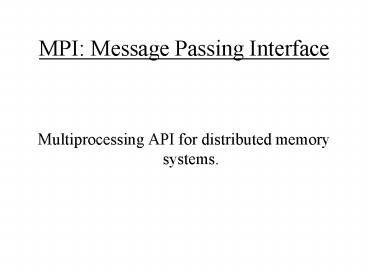MPI: Message Passing Interface - PowerPoint PPT Presentation
1 / 14
Title:
MPI: Message Passing Interface
Description:
Message passing is a computational model in which processes have only local ... Upshot: a viewer for MPE logs. For more information: ... – PowerPoint PPT presentation
Number of Views:25
Avg rating:3.0/5.0
Title: MPI: Message Passing Interface
1
MPI Message Passing Interface
- Multiprocessing API for distributed memory
systems.
2
What is Message Passing?
- Message passing is a computational model in which
processes have only local memory (they lack a
common shared memory), but are able to
communicate with other processes by sending and
receiving messages.
3
Where can we use Message Passing?
Message passing can be used where-ever it is
possible for processes to exchange messages
- Distributed memory systems
- Networks of Workstations
- Even, shared memory systems.
4
MPI The Message Passing Interface
- MPI is an API for parallel programming on
distributed memory systems. Specifies a set of
operations, but says nothing about the
implementation. - Popular because it many vendors support it,
therefore is very portable. - Most common implementation MPICH.
5
MPI
MPI provides specifications for
- Process creation
- Process termination
- Process ordering
- Interprocess Communication
6
MPI Operations Basic Set.
MPI can be thought of as a small specification,
because any complete implementation need only
provide the following operations
- MPI_INIT
- MPI_COMM_SIZE
- MPI_COMM_RANK
- MPI_SEND
- MPI_RECV
- MPI_FINALIZE
7
MPI Datatypes.
MPI specifies datatypes explicitly in the
message. Why? Because we may have a cluster of
heterogeneous machines. Word sizes and data
formats may differ.
- MPI_INT
- MPI_FLOAT
- MPI_BYTE
- MPI_CHAR
- etc
8
Example Programs.
- Simple Hello world in C.
- Hello World with process ids.
- A simple sum program.
9
MPI Operations Extended Set.
- MPI_BCAST
- MPI_REDUCE
10
Buffered and Non-Blocking Communication.
- MPI_Bsend
- MPI_Brecv
- MPI_Isend
- MPI_Irecv
- MPI_Ssend
- MPI_Srecv
11
Groups and Communicators.
- A group is a collection of processes. The
processes within a group are ordered by their
ranks. - The notion of a group and the context are
combined in a single object called communicator.
12
Topologies.
- Many problems conceptually fit best on
particular topologies. Ex the 2D Poisson
equation is best solved on a 2D array of
processes. - MPI provides a routines to create topologies,
particularly Cartesian topologies - MPI_CART_CREATE
- MPI_CART_COORDS
13
MPICH tools.
- MPICH provides, apart from an implementation of
MPI, a set of tools for visualization and
debugging. - MPE - Multiprocessing environment set of tools
which provide routines for Graphing,
visualization, logging, etc. - Upshot a viewer for MPE logs.
14
For more information
- Using MPI Portable Parallel Programming with the
Message Passing Interface, Gropp, et. al. - www.mcs.anl.gov/mpi
Exercises 1. Could look at the code for
calculating pi in the book and figure it out. 2.
Could write a simple sum program which reads
numbers from a file and adds them.





























